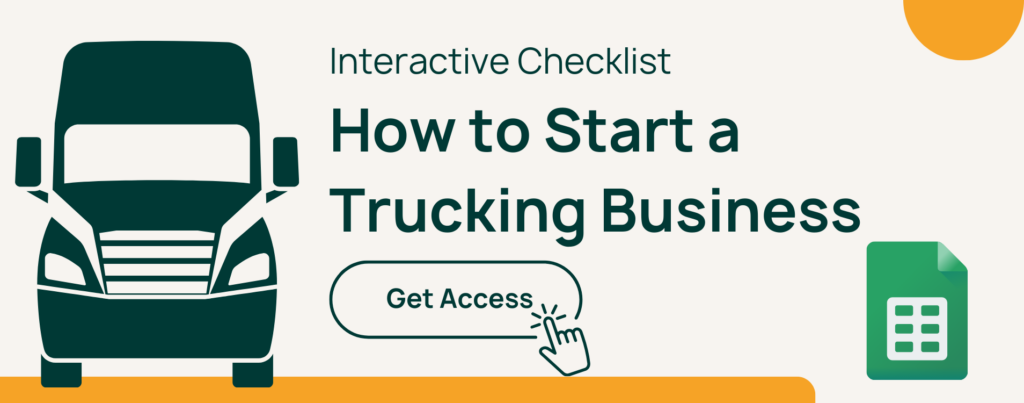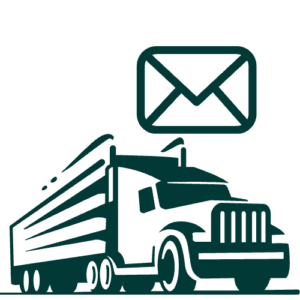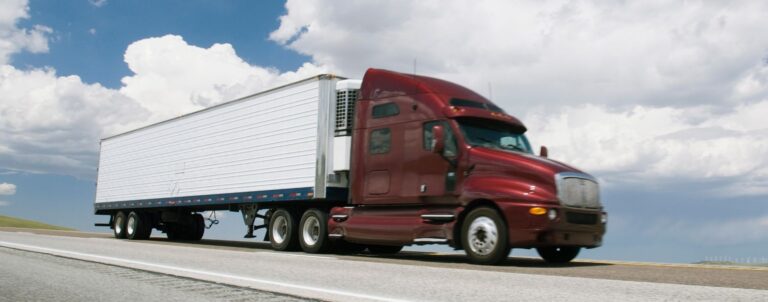How To Start An Owner-Operator Trucking Business In 10 Steps
Maybe you’ve been working as a company driver for years, and you’re ready to go into business for yourself. Maybe you’re a logistics entrepreneur ready to haul freight alongside an expanding fleet. Either way, you need to know how to start a trucking business as an owner-operator—a task that differs considerably from less independent entries into the industry. This owner-operator startup guide tells you everything you need to know.
(PS: Our interactive checklist helps you organize the information and documents you need when starting a trucking business! Click below to access the tool.)

The Owner-Operator Business: Advantages And Challenges To Consider
There are lots of reasons why experienced drivers and first-time carriers alike may want to start an owner-operator trucking company. Owner-operators enjoy a range of benefits compared to company drivers:
- You get to be your own boss. See a workflow process that can be improved? You’re free to improve it. Rather drive in the evenings than the daytime? Go ahead. When you run the company, you make the rules—and that gives you unmatched flexibility in everything from scheduling to reinvesting your profits.
- You control freight and routes. The flexibility of self-employment allows you to carve out your own niche. You might prefer to stick close to family, operating only on routes that get you home a few times a week. If you’re not comfortable with HAZMAT or refrigerated products, there’s no need to carry them. You pick the freight, too.
- You can configure your truck however you like. Carriers may assign any available vehicle, whether you have an affinity for that truck or not. As an owner-operator, you’re the one buying the equipment. That means you can outfit your rig to provide the ideal driving experience for you.
- You keep 100% of the profits. Rather than working solely for a wage, an owner-operator retains control of the profits. It’s up to you whether you’d like to re-invest in your business or simply take home more of the value your company creates. This may be the top reason company drivers make the move to operating their own business.
Of course, there’s another side to the owner-operator coin. Company drivers have limited, clearly delineated responsibilities. As a business owner, you’ll face a lot of work that employees don’t. The challenges of running your own trucking business include:
- You’re responsible for business management tasks. You may hire a third-party service to help with the day-to-day operations of your business, but as the owner, the buck stops with you. That means you’ll spend a fair portion of your workweek on tasks like compliance, budgeting, quarterly and annual reporting, accounting, fuel tax filings, insurance—the list goes on.
- You bear all the startup costs. Money is the greatest barrier between employment as a company driver and becoming an owner-operator. You’ll need financing to get your operation up and running, and if you don’t have a hefty sum set aside, that may require bank loans—and the considerable paperwork that goes along with them.
- You have to pay all the business-related taxes.This is actually an advantage as well as a disadvantage; business owners realize a lot of tax benefits not available to employees. However, business taxes are more complicated for owners than for earners. You’ll be taxed not just on your salary but also on profits, potentially leading to higher payments overall—and certainly requiring more paperwork.
- Cash flow can be a challenge, especially in the early days of your trucking business.In addition to startup financing, you’ll need to cover expenses while you build up an operating budget. In an industry where customers have 30 or even 60 days to pay their invoices—payment terms described as net-30 or net-60—that can be a problem. Factoring can step in to bridge the gap. This financial service involves third-party financing that pays your outstanding invoices quickly, collecting later from the customer—but not all factoring services are equally advantageous.
With traditional factoring companies, it’s easy to get bogged down in hidden fees, slow payments, and complicated processes. Bobtail provides the solution. Open the Bobtail app to enter freight details, upload a bill of lading, and get paid that same day (or the following day if you upload your information in the evening). There’s just one low factoring fee—no hidden costs, no surprises. Plus, Bobtail’s dedicated customer support ensures a smooth, hassle-free experience. It’s the simplest and most profitable way to fund your owner-operator business through the early growth stages—and beyond.
Ready to get funding for your owner-operator trucking business? Start factoring with Bobtail today.
The Trucking Owner-Operator: How To Get Started
Most new owner-operators are eager to get on the road, but first you have to get your affairs in order. Follow these 10 steps to start your owner-operator business and begin hauling freight as quickly as possible.
1. Obtain a federal tax ID.
The first step toward starting a trucking business in the United States is to register with the Internal Revenue Service (IRS). You can accomplish this by filing for an Employer Identification Number, or EIN. The EIN functions like your company’s social security number, allowing you to pay all required federal and state taxes. Luckily, it’s quick and relatively easy to get your EIN. Just use the IRS’ EIN Assistant tool to apply online.
2. Register your business in your state of residence.
You establish your business as a legal entity at the state level. You may operate as a sole proprietor, a limited liability company (LLC), or even a partnership; regardless of which you choose, your state will require registration through the Secretary of State’s office or your state’s business agency. Find the relevant state website with the Small Business Association’s guide, and then follow the instructions to found your business officially.
3. File for a USDOT number.
To haul freight between state lines, most states require you to have a Department of Transportation (DOT) number, assigned by the Federal Motor Carrier Safety Administration (FMCSA). This unique number identifies your business for federal safety monitoring, audits, inspections, and other regulatory proceedings. Get your USDOT number through FMCSA’s United Registration System.
4. Apply for Operating Authority with the Federal Motor Carrier Safety Administration (FMCSA).
Along with the USDOT number, FMCSA requires most carriers to obtain Authority to Operate, indicated by the designation of a Motor Carrier (MC) number. The fee for this authorization is currently $300, and you can apply through the United Registration System on the FMCSA website, the same tool you use to get the USDOT number.
5. Sign up for the FMCSA Drug and Alcohol Clearinghouse and maintain DOT compliance.
Both FMCSA and DOT require CDL holders to register with the Commercial Driver’s License Drug and Alcohol Clearinghouse. Additionally, you will need to join a drug and alcohol testing consortium, which will place you in a random testing pool to ensure ongoing compliance. You must also maintain a Driver Qualification File (DQF) with initial documents and ongoing updates, including but not limited to pre-employment drug screening, passing an annual DOT physical, maintaining an active CDL-A license, and reviewing driving records.
6. Complete a successful New Entrant Safety Audit with FMCSA.
At some point in the first 12 months of your new operation, your business must pass a Safety Audit through FMCSA. In order for your DOT number to remain active, you must remain compliant. Any violations found can involve hefty fines and your business can be put out of service until issues are resolved. Contact FMCSA through its Safety Audit information page for more information on preparing for this step.
7. Secure a license with the International Fuel Tax Agreement (IFTA).
The International Fuel Tax Agreement simplifies the collection and payment of fuel use taxes across states and in the Canadian provinces bordering the U.S. An IFTA license allows you to engage in interstate travel while paying a single quarterly tax on fuel, no matter where the purchase takes place. Apply for an IFTA license through your state’s relevant agency, which IFTA refers to as a “base jurisdiction.” Find your base jurisdiction with IFTA’s locator tool.
8. Buy or lease a rig and license it.
Leasing a truck—essentially renting for a set term—involves fewer up-front costs than buying a truck outright. If you can afford a down payment, on the other hand, buying your rig could save you money in the long run. Either way, you’ll need a dependable, fully licensed vehicle to get your owner-operator trucking business up and running.
9. Insure your operation.
In order to insure your truck and your business, you’ll need to complete the preceding steps. Regulatory bodies from states to FMCSA place minimum insurance requirements on carriers; talk to an insurance professional for details in your area. Different insurers may provide varying rates, so it pays to shop around, starting with a simple internet search for “commercial truck insurance.”
10. Install an FMCSA-certified Electronic Logging Device (ELD) in your cab.
Drivers must keep records of duty service (RODS) that track driving time, hours of service (HOS), and other performance data. Since 2019, U.S. law requires drivers to use ELDs to maintain these records automatically. Refer to this list of ELDs certified by FMCSA, and install one before your first haul.
With these 10 steps complete, you’re ready for the next set of challenges: finding customers, accepting jobs, and hauling freight—all subjects for later posts. The first step is understanding how to start a trucking business as an owner-operator, and with this information in hand, you’re ready to begin. To keep operating funds flowing quickly as your business grows, call Bobtail at 410-204-2084 for full-service factoring with no hidden fees and exceptional support.

Article By
Keep Learning












